| Reproduction in Organisms Refresher Course |
| Reproduction in Organisms Concepts Files |
| Reproduction in Organisms Master Files |
| Reproduction in Organisms Revision Note |
| Reproduction in Organisms Note 1 |
| Reproduction in Organisms Reference Book |
Reproduction in Organisms
Table of Content
Reproduction is defined as the ability of an organism to produce new individuals. There are basically two types of reproduction- asexual reproduction and sexual reproduction.
Asexual Reproduction
In this mode of reproduction, a single parent is involved. Individuals formed are identical to their parents. Such individuals are known as clones. They are morphologically and genetically identical to their parents. It is more common in single celled organisms, some plants and animals.
Different types of Asexual Reproduction
- Binary fission is the most common form of reproduction in prokaryotes and in some single celled prokaryotes. A parent cell divides into two equal parent cells after replicating genetic material. For example, Amoeba and Paramecium. First, genetic material gets duplicated so that each daughter cells will receive an equal amount of genetic material. The duplication of genetic material is followed by division of cell into two daughter cells. This is known as cytokinesis.
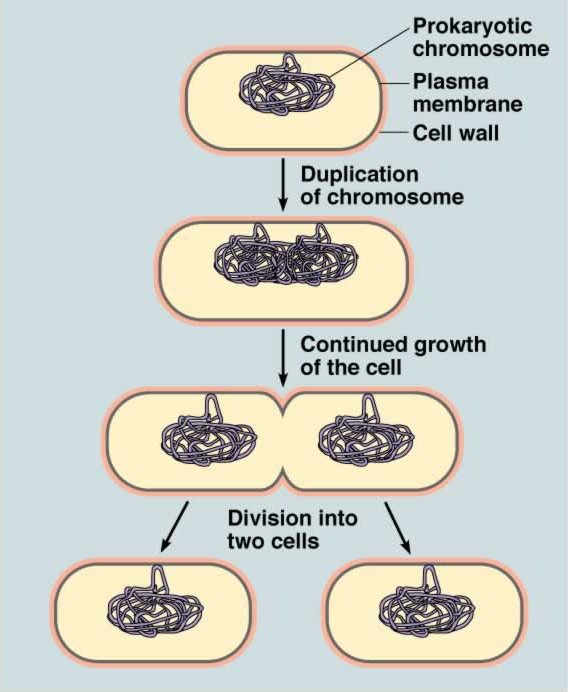
Fig.1. Binary fission
- Budding is a form of asexual reproduction in which a new organism arises from the outgrowth of the parent. The outgrowth is known as bud. The new organism or bud matures while attached to the parent. After maturation, the organism detaches from the parent body and lives an independent life. Budding is common in Hydra. It also occurs in Yeast.
Sporogenesis is the formation of spores. This type of asexual reproduction occurs when conditions are unfavorable. For example, some plants, fungi, and algae. Zygospores are spores formed in some fungi such as Rhizopus.
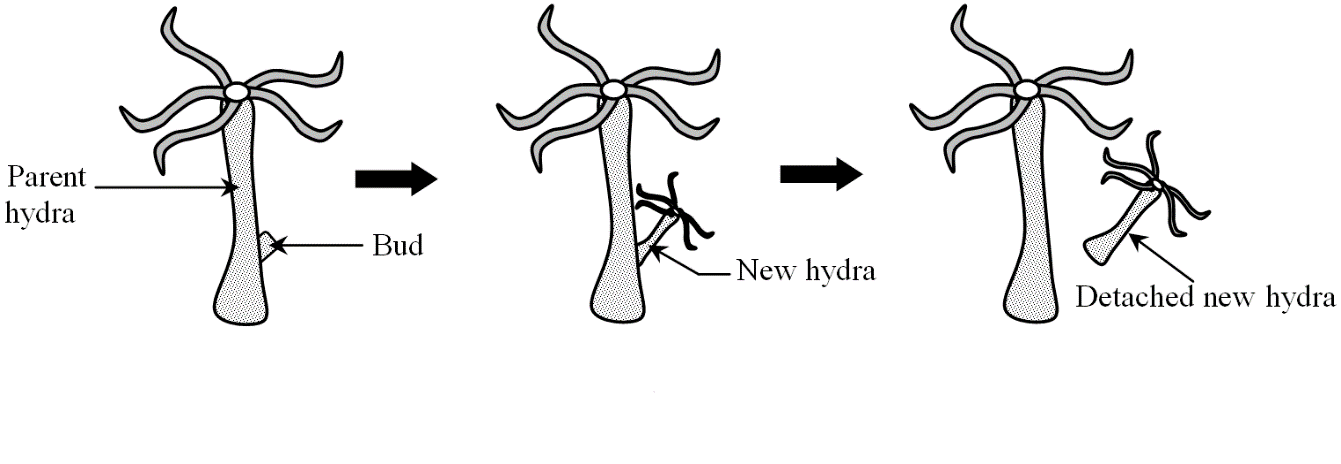
Fig.2. Budding in Hydra
- Fragmentation is a form of asexual reproduction in which new organism is formed from the fragment of the parent. The fragment is formed by splitting of the parent plant. Splitting can occur naturally or by some predators. For example, gemma in Liverworts are reproductive structures that help in asexual reproduction via fragmentation. It is also common in cyanobacteria, molds and lichens. Fungi such as mushrooms, yeasts reproduce by producing tiny filaments known as hyphae. These hyphae functions in obtaining food and nutrients from the body of the other organisms.
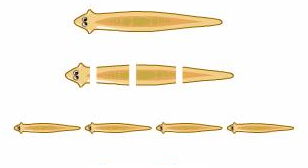
Fig.3. Fragmentation
- Parthenogenesis is a form of asexual reproduction in which organism is from the unfertilized egg. Parthenogenesis should not be confused with hermaphroditism. In hermaphrodites, reproductive organs from both the sexes are present within the same organism whereas in case of parthenogenesis, single haploid organism will produce new organism without being fertilized. The term fertilization can be used for hermaphrodites but not for parthenogenetic organisms.
- Vegetative reproduction involves single parent organism. There are various reproductive structures as explained – Rhizome is the common vegetative structure which is an underground modified stem. For example, Polypodium.
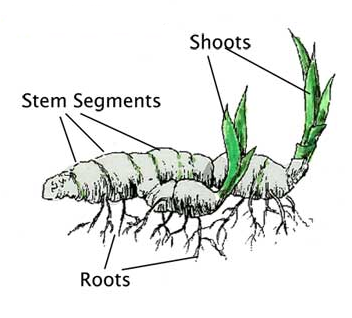
Fig.4. Rhizome
Runners or stolons are aerial, prostrate stems. For example, Grasses. Some plants such as Potatoes and Dahlia reproduce via tubers. Suckers also reproduce by vegetative reproduction. Regeneration of a plant occur by shoots that arise from an existing root system. Some reproduce by bulb-like structure is known as corm. For example, Gladioli. Plants like onion, tulips reproduce by bulbs. In few species, leaves are also involved in vegetative reproduction.
Vegetative reproduction is natural as well as artificial.

Advantages of Asexual Reproduction
- Less time and energy is needed.
- No mates are required
Disadvantages of Asexual Reproduction
- No variation as offspring are clones of their parents.
- They are more prone to extinction.
Sexual Reproduction
Sexual reproduction involves male gamete and female gamete. Male and female gametes fuse to form a zygote. Zygote will then undergo various divisions to form a new organism. The new organism formed is not identical to their parents as compared to asexual reproduction. The offspring’s formed from sexual reproduction contains genetic material from both the parents, that is, half number of chromosomes from the mother and half chromosomes from the father.
To reproduce sexually, organisms need to reach a level of maturity. This phase is known as juvenile phase. For plants, the term vegetative phase is used.
Different phases in sexual reproduction
- Juvenile phase– It is a phase of growth and maturity before a person reaches reproductive maturity. This phase is variable in nature. It varies with different organisms
- Reproductive phase– It is the phase when a person reaches sexual maturity. For example, some flowers reproduce seasonally and some flowers reproduce throughout the year. During reproductive phases, female mammals undergo a cycle known as menstrual cycle. Apes undergo oestrus cycle.
- Senescent phase– It is the end of the reproductive phase. It is marked with the death phase. Every organisms in the last reaches to this phase.
Events in Sexual Reproduction
Events of sexual reproduction are divided into- pre-fertilization, fertilization, and post fertilization.
Pre-fertilization events
The two processes that are a part of pre-fertilization events are gametogenesis and gamete transfer. The formation of male and female gamete is known as gametogenesis. Gametes are haploid in nature. There are two types of gametes- homogametes and heterogametes. When the male and female gamete cannot be differentiated morphologically, the gametes are known as homogametes or isogametes. For example, Cladophora (an algae). When male and female gamete can be differentiated morphologically, such gametes are known as heterogametes. The heterogametes such as antherozoid or male gamete and female gamete is ovum or egg.
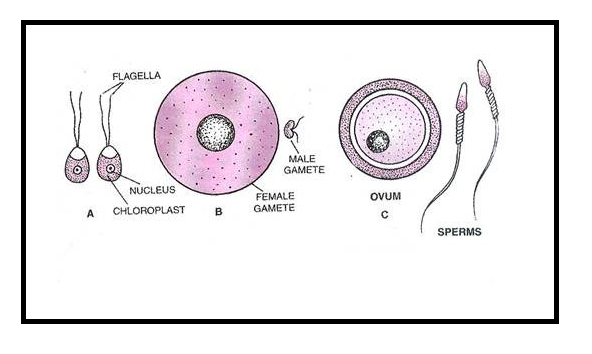
Fig.6. A-isogametes in Cladophora. B. Herogametes in Ficus. C. Heterogametes in humans
In case of humans which are heterogametic, the female gamete is immotile and large in size as compared to male gamete which are motile and smaller in size.
Sexuality in Organisms
Plants having male and female structures within the same plant are known as bisexual plants. In fungi, the word homothallic is used whereas for plants monoecious word is used for unisexual plants. Example of monoecious plant is cucurbits. Plants having male and female structures on different plants, are known as bisexual plants. The heterothallic and dioecious are used for fungi and plants respectively. Example of dioecious plant is papaya. Unisexual flowers with stamen are known as staminate whereas unisexual female flowers with pistils are known as pistillate.
Bisexual organisms having both male and female reproductive structures are known as hermaphrodite. For example, Earthworm. In earthworm, testis and ovaries are present in the same organism.
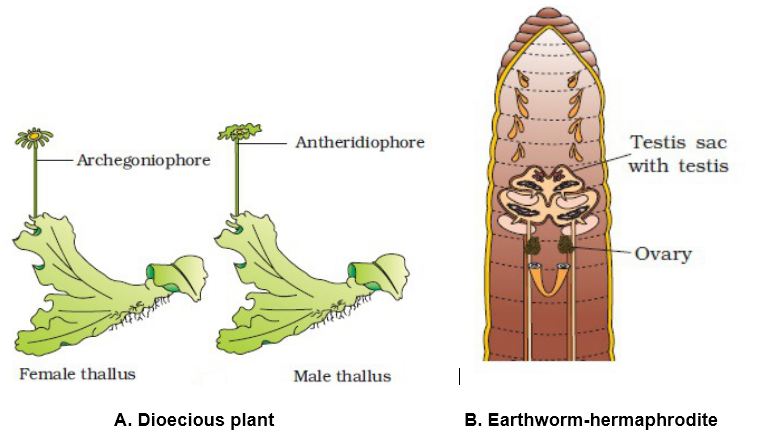
Fig. 7. Sexuality in organisms
Organisms belonging to monera, fungi, algae etc., have haploid parent body. But complex organisms such as plants belonging to gymnosperms, angiosperms and animals including humans are diploid in nature. For reproduction, these organisms produce haploid gametes via process of meiosis. Cells that form gametes are known as meiocytes. These meiocytes undergo meiosis to form gametes.
For the formation of new organism, gametes need to come together for fusion. Exceptions are there in case of asexual reproduction. In some plants, both the gametes are motile. But in case where one gamete is motile and other gamete is non-motile there is a need of a medium for mating of the gametes. For example, in algae, bryophytes, pteridophytes, water act as a medium for gamete transfer.
Water serves as a poor medium of gamete transfer, as most of the sperm produced do not reach the target female gamete. To compensation this, many male gametes are produced as compared to female gamete.
Other higher organisms use pollination as the mode of gamete transfer. It is the process of transfer of pollen from the anther to the stigma of the flower. Pollen grain lands on the stigma of the flower, then it reaches the egg and discharge the male gametes. One of the male gamete fertilizes the egg to form zygote and another one is involved in the formation of endosperm. This is known as double fertilization. This is the characteristic mechanism of Angiosperms.
Fertilization
The most important event during sexual reproduction is fusion of gametes. The fusion of male gamete and female gamete is known as fertilization. This process is also known as syngamy. Fertilization results in the formation of zygote. In some organisms, such as rotifers, honeybees, syngamy do not occur. They reproduce via process known as parthenogenesis. During parthenogenesis, female gamete develops to form new organism without fertilization.
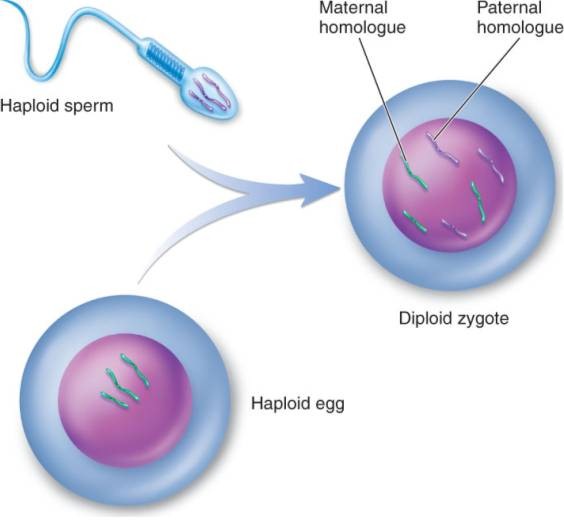
Fig.8. Human fertilization
There are two types of fertilization- external fertilization and internal fertilization. When fertilization occurs outside the body of an organisms such as in water, is known as external fertilization. This is common in aquatic animals such as algae and fishes. This type of fertilization results in the formation of large number of organisms. The major disadvantage of external fertilization is that offsprings are more vulnerable to predators.
In higher organisms, fertilization is internal, that is, fertilization occurs inside the body of an organism. This type of fertilization is known as internal fertilization. During internal fertilization, fertilization occurs inside the female body. Sperms must reach the female body for fertilization to occur. Thus, male gamete is motile and female gamete is non-motile. In internal fertilization, less female gametes are produce but male gametes are large in number. Male gametes are motile but female gametes are non-motile.
Post Fertilization Events
Events after fertilization or after the formation of the zygote is known as post fertilization events.
Zygote is the first event that occurs after fertilization. Zygote is diploid in nature. In fungi and algae, zygote develops as a thick wall that is resistant to desiccation and damage. Zygote undergo a period of dormancy before it germinates to form a new organism.
Embryogenesis is defined as the process of development of embryo from the zygote. Cell division and cell differentiation are two steps that occurs during embryogenesis. Cell division involves mitosis. Mitosis increases the number of cells. Group of cells then get specialized for a function. This is known as differentiation.
In animals including humans, zygote undergo different stages of cleavage. Zygote undergo mitosis to form ball of mass known as morula. Morula undergo further divisions to form blastula. Blastula then divides to form gastrula. Gastrula contains two types of cells- trophoblast and inner cell mass. Inner cell mass give rise to different parts of the embryo. Gastrula is then implanted into uterine lining. This is marked as pregnancy. Different hormones are involved in maintaining the pregnancy. During gastrulation, three germ layers are formed- ectoderm, mesoderm, and innermost endoderm. These germ layers form different organs in the embryo. For example, nervous system is formed from the ectoderm.
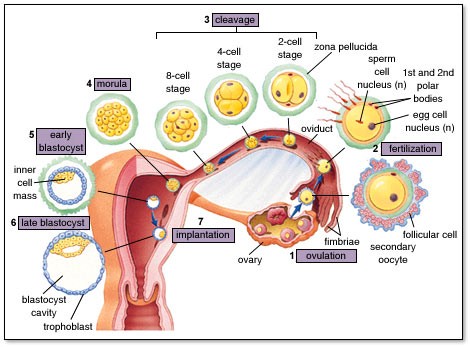
Fig.9. Embryogenesis in humans
Animals are also categorized on the basis whether the parent organism will lay egg or give birth to young ones.
When an animal lay eggs covered by a hard-calcareous covering, such animals are known as oviparous animals. Thus, these animals lay eggs instead of giving birth to young ones. The zygote develops into young ones inside the body of the female organism. After sometime, the egg is released outside the female body. But other animals including human beings give birth to young ones, such animals are known as viviparous animals.
Ovoviviparity is a mode of reproduction in animals in which embryos develop inside eggs remain in the mother’s body until and unless they are ready for hatching. This method of reproduction is similar to viviparity, but the embryos do not have any placental connection with the mother. They obtain the nourishment from the yolk sac. For example, amphibians. Ovuliparity is common in arthropods. In this mode of reproduction, fertilization is external with almost no embryonic development inside the mother’s body.
In case of flowering plants, the zygote is formed inside the female gametophyte also known as ovule. Ovule develops into seed whereas zygote develops into embryo and ovary develops into fruit. The wall of the ovary is known as pericarp.
A mature seed can be ex-albuminous or non-albuminous seed. Albuminous seeds retain a part of the endosperm during embryo development. For example, wheat, maize, barley etc. The left-over part of the embryo is known as perisperm. In case of non-albuminous seed, the endosperm is completely consumed during embryo development. For example, pea and groundnut.